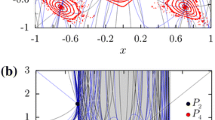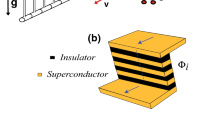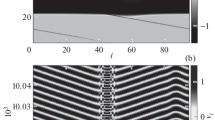Abstract
In the present paper, we study the fundamental mechanism of unidirectional energy transport in the symmetric, weakly dissipative system of two coupled nonlinear oscillators and weakly coupled oscillatory chains. We demonstrate that under particular choice of system parameters the model under consideration allows the irreversible transfer of energy from the initially excited oscillator to the initially resting one. In the second part of the paper, we implement the mechanism for control of spatially localized nonlinear waves (discrete breathers) in weakly dissipative, coupled oscillatory chains. This mechanism is implemented on the symmetric system of two weakly dissipative, non-linearly coupled oscillatory chains. Using the regular multi-scale asymptotic analysis, we derive the slow flow system. Further applying the method of collective coordinates on the slow flow system, we were able to describe analytically the mechanism of unidirectional inter-chain transport of static breathers. In general, the analytical method developed in the paper allows one to predict the special regions in the parametric space corresponding to the formation of the aforementioned regimes of irreversible energy transfer in the system of non-linearly coupled oscillators and oscillatory chains.















Similar content being viewed by others
References
Scott, A.: Emergence and Dynamics of Coherent Structures, in Nonlinear Science. Oxford University Press, Oxford (1999)
Hodges, C.: Confinement of vibration by structural irregularity. J. Sound Vib. 82, 411–424 (1982)
Pierre, C., Dowell, E.H.: Localization of vibrations by structural irregularity. J. Sound Vib. 114, 549–564 (1987)
Bendiksen, O.: Mode localization phenomena in large space structures. AIAA J. 25, 1241–1248 (1987)
Cai, C.W., Chan, H.C., Cheung, Y.K.: Localized modes in a two-degree-coupling periodic system with a nonlinear disordered subsystem. Chaos Solitons Fractals 11, 1481–1492 (2000)
Gendelman, O., Manevitch, L.I., Vakakis, A.F., M’Closkey, R.: Energy pumping in nonlinear mechanical oscillators: part I—dynamics of underlying Hamiltonian systems. Appl. Mech. 68(1), 34 (2001)
Gendelman, O., Vakakis, A.F.: Transition from localization to nonlocalization in strongly nonlinear damped oscillators. Chaos Solitons Fractals 11, 1535–1542 (2000)
Vakakis, A.F.: Inducing passive nonlinear energy sinks in vibrating systems. J Vib Acoust Trans ASME 123(3), 324–332 (2001)
Gendelman, O.V.: Transition of energy to a nonlinear localized mode in a highly asymmetric system of two oscillators. Nonlinear Dyn. 25(1–3), 237–253 (2001)
Vakakis, A.F., Gendelman, O.V.: Energy Pumping in nonlinear mechanical oscillators: part II—resonance capture. Appl. Mech. 68(1), 42 (2001)
Vakakis, A., Gendelman, O.V., Bergman, L., McFarland, M., Kerschen, G., Lee, Y.: Nonlinear Targeted Energy Transfer in Mechanical and Structural Systems. Springer, New York (2008)
McFarland, D.M., Bergman, L., Vakakis, A.: Experimental study of non-linear energy pumping occurring at a single fast frequency. Int. J. Non-Linear Mech. 40, 891–899 (2005)
McFarland, D.M., Kerschen, G., Kowtko, J., Lee, Y.S., Bergman, L.A., Vakakis, A.F.: Experimental investigation of targeted energy transfers in strongly and nonlinearly coupled oscillators. J. Acoust. Soc. Am. 118, 791–799 (2005)
Manevitch, L.I.: New approach to beating phenomenon in coupled nonlinear oscillatory chains. Arch. Appl. Mech. 77(5), 301–312 (2007)
Manevitch, L.I., Gendelman, O.: Tractable Models of Solid Mechanics. Springer, Berlin (2011)
Manevitch, L.I., Musienko, A.I.: Limiting phase trajectories and energy exchange between anharmonic oscillator and external force. Nonlinear Dyn. 58(4), 633–642 (2009)
Manevitch, L.I., Smirnov, V.V.: Limiting phase trajectories and the origin of energy localization in nonlinear oscillatory chains. Phys. Rev. E 82(3), 036602 (2010)
Manevitch, L.I., Kovaleva, A.S., Shepelev, D.S.: Non-smooth approximations of the limiting phase trajectories for the Duffing oscillator near 1:1 resonance. Phys. D Nonlinear Phenom. 240(1), 1–12 (2011)
Kovaleva, A., Manevitch, L.I., Manevitch, E.L.: Intense energy transfer and superharmonic resonance in a system of two coupled oscillators. Phys. Rev. E 81, 056215 (2010)
Smirnov, V.V., Manevitch, L.I.: Limiting phase trajectories and dynamic transition in nonlinear periodic systems. Acoust. Phys. 57(271), 271–276 (2011)
Smirnov, V.V., Shepelev, D.S., Manevitch, L.I.: Energy exchange and transition to localization in the asymmetric Fermi–Pasta–Ulam oscillatory chain. Eur. Phys. J. B 86, 10 (2013)
Manevitch, L.I., Smirnov, V.V.: Resonant energy exchange in nonlinear oscillatory chains and Limiting phase trajectories: from small to large systems. In: Vakakis, A.F. (ed.) Advanced Nonlinear Strategies for Vibration Mitigation and System Identification, vol. 518, pp. 207–258. CISM International Centre for Mechanical Sciences, Udine (2010)
Manevitch, L.I., Kovaleva, A.S., Manevitch, E.L., Shepelev, D.S.: Limiting phase trajectories and non-stationary resonance oscillations of the Duffing oscillator. Part 1. A non-dissipative oscillator. Commun. Nonlinear Sci. Numer. Simul. 16(2), 1089–1097 (2011)
Manevitch, L.I., Kovaleva, A.S., Manevitch, E.L., Shepelev, D.S.: Limiting phase trajectories and non-stationary resonance oscillations of the Duffing oscillator. Part 2: a dissipative oscillator. Commun. Nonlinear Sci. Numer. Simulat. 16, 1089–1097 (2011)
Manevitch, L.I.: Energy exchange, localization, and transfer in nanoscale systems (weak-coupling approximation). Russ. J. Phys. Chem. B 6, 563–581 (2012)
Manevitch, L.I., Kovaleva, A.: Nonlinear energy transfer in classical and quantum systems. Phys. Rev. E 87(2), 22904 (2013)
Kovaleva, A., Manevitch, L.I.: Resonance energy transport and exchange in oscillator arrays. Phys. Rev. E 88(2), 022904 (2013)
Starosvetsky, Y., Ben Meir, Y.: Nonstationary regimes of homogeneous Hamiltonian systems in the state of sonic vacuum. Phys. Rev. E 87(6), 062919 (2013)
Manevitch, L.I., Kosevich, Y.A., Mane, M., Sigalov, G., Bergman, L.A., Vakakis, A.F.: Towards a new type of energy trap: classical analog of quantum Landau–Zener tunneling. Int. J. Non-Linear Mech. 46(1), 247–252 (2011)
Kovaleva, A., Manveitch, L.I., Kosevich, Y.A.: Fresnel integrals and irreversible energy transfer in an oscillatory system with time-dependent parameters. Phys. Rev. E 83, 026602 (2011)
Kovaleva, A., Manevitch, L.I.: Classical analog of quasilinear Landau-Zener tunneling. Phys. Rev. E 85, 016202 (2012)
Hasan, M.A., Starosvetsky, Y., Vakakis, A.F., Manevitch, L.I.: Nonlinear targeted energy transfer and macroscopic, analog of the quantum Landau–Zener effect in coupled granular chains. Phys. D 252, 46–58 (2013)
Kovaleva, A., Manevitch, L.I.: Limiting phase trajectories and emergence of autoresonance in nonlinear oscillators. Phys. Rev. E 88, 024901 (2013)
Nesterenko, V.F.: Dynamics of Heterogeneous Materials. Springer, New York (2001)
Kislovsky, V., Kovaleva, M., Jayaprakash, K.R., Starosvetsky, Y.: Consecutive transitions from localized to delocalized transport states in anharmonic chain of three coupled oscillators. Chaos Interdiscip. J. Nonlinear Sci. 26(7), 73102 (2016)
Starosvetsky, Y., Hasan, M.A., Vakakis, A.F., Manevitch, L.I.: Strongly nonlinear beat phenomena and energy exchanges in weakly coupled granular chains on elastic foundations. SIAM J. Appl. Math. 72(1), 337–361 (2012)
Smirnov, V.V., Manevich, L.I.: Limiting phase trajectories and dynamic transitions in nonlinear periodic systems. Acoust. Phys. 57(2), 271–276 (2011)
Vakakis, A.F., Gendelman, O.V., Bergman, L.A., Mcfarland, D.M., Lee, Y.S.: Nonlinear Targeted Energy Transfer in Mechanical and Structural Systems. Springer, Berlin (2009)
Vakakis, A.F.: Advanced Nonlinear Strategies for Vibration Mitigation and System Identification. Springer, Berlin (2010)
Wierschem, N.E., Luo, J., Al-Shudeifat, M., Hubbard, S., Ott, R., Fahnestock, L.A., Quinn, D.D., Mcfarland, D.M., Spencer Jr., B.F., Vakakis, A.F., Bergman, L.A.: Experimental testing and numerical simulation of a six-story structure incorporating two-degree-of-freedom nonlinear energy sink. J. Struct. Eng. 140(6), 1–10 (2014)
Luo, J., Wierschen, N.E., Hubbard, S.A., Fahnestock, L.A., Quinn, D.D., Mcfarland, D.M., Spencer Jr., B.F., Vakakis, A.F., Bergman, L.A.: Large-scale experimental evaluation and numerical simulation of a system of nonlinear energy sinks for seismic mitigation. Eng. Struct. 77, 34–48 (2014)
Gendelman, O.V., Gorlov, D.V., Manevitch, L.I., Musienko, A.I.: Dynamics of coupled linear and essentially nonlinear oscillators with substantially different masses. J. Sound Vib. 286(1–2), 1–19 (2005)
Hasan, M.A., Cho, S., Remick, K., Vakakis, A.F., Mcfarland, D.M., Kriven, W.M.: Primary pulse transmission in coupled steel granular chains embedded in PDMS matrix: experiment and modeling. Int. J. Solids Struct. 50(20–21), 3207–3224 (2013)
Porter, M.A., Daraio, C., Herbold, E.B., Szekengowicz, I., Kevrekidis, P.G.: Highly nonlinear solitary waves in periodic dimer granular chains. Phys. Rev. E 77, 01560 (2008)
Porter, M.A., Daraio, C., Szelengowicz, I., Herbold, E.B., Kevrekidis, P.G.: Highly nonlinear solitary waves in heterogeneous periodic granular media. Phys. D 238(6), 666–676 (2009)
Yang, J., Dunatunga, S., Daraio, C.: Amplitude-dependent attenuation of compressive waves. Acta Mech. 223(3), 549–562 (2012)
Manevitch, L.I.: New approach to beating phenomenon in coupled nonlinear oscillatory chains. Arch. Appl. Mech. 77(5), 301–312 (2007)
James, G., Kevrekidis, P.G., Cuevas, J.: Breathers in oscillator chains with Hertzian interactions. Phys. Nonlinear Phenom. 251, 39–59 (2013)
James, G., Starosvetsky, Y.: Breather solutions of the discrete p-Schrodinger equation. In: Luo, A.C.J., Carretero-Gonzalez, R, Cuevas-Maraver, J., Frantzeskakis, D., Karachalios, N., Kevrekidis, P., Palmero-Acebedo, F. (eds.) Localized Excitations in Nonlinear Complex Systems, pp. 77–115. Springer, Berlin (2013)
James, G.: Nonlinear waves in Newton’s cradle and the discrete p-Schrodinger equation. Math. Models Methods Appl. Sci. 21(11), 2335–2377 (2011)
Abramowitz, M., Stegun, I.A.: Handbook of Mathematical Functions. Dover Publication Inc, New York (1970)
Acknowledgements
V. K. and Y. S. are grateful to Israel Science Foundation (Grant No. 1079/16) for financial support. M.K. is thankful to Russian Foundation for Basic Research (Grant No. 18-03-00716) for financial support. We thank O. Gendelman for fruitful discussions in the course of preparing the manuscript.
Author information
Authors and Affiliations
Corresponding author
Ethics declarations
Conflict of interest
The authors declare that they have no conflict of interest.
Additional information
Publisher's Note
Springer Nature remains neutral with regard to jurisdictional claims in published maps and institutional affiliations.
Appendix
Appendix
Projection of the resonant nonlinear terms for the resonant conditions brought in (8).
Complexification and averaging are obtained via the following integral expression:
The pure imaginary constant \(\frac{i\gamma }{2}\) was added due to the Hamiltonian structure of the conservative force. 1 / 2 was added due to the averaging of the linear term, and \(\,\gamma >0\) because the force is of the restoring type. We need to calculate the parameter \(\gamma \). The complex representation of the displacement is \(x=\frac{-i}{2}\left( {\varphi e^{it}-\varphi ^{*}e^{-it}} \right) \,\) where \(\varphi =\varphi \left( {\tau _{1} } \right) =\left| \varphi \right| e^{i\lambda }\) is the zero order of the asymptotic approximation with the amplitude \(A\left( {\tau _{1} } \right) =\left| \varphi \right| \) and the phase \(angle\left( \varphi \right) =\lambda \left( {\tau _{1} } \right) \). Both amplitude and phase vary on the slow timescale \(\tau _{1} =\varepsilon t\). Substituting the complex form in (50) leads to the following expression of the force,
or
where the non-smooth expression was simplified as follows:
and the smooth term can be transformed in the similar way,
By direct substitution of (52) or (54) into the integral yields the following expression,
Thus, we need to evaluate the integral \(I=\int _0^{2\pi } {\sin \left( {\lambda + t} \right) }\)\(\left| {\sin \left( {\lambda +t} \right) } \right| ^{a}e^{-it}\mathrm{d}t\). Transforming
The integral yields
For better understanding, we can make the symmetric boundaries as well by transforming again \(u=w+\pi , w=u-\pi , \mathrm{d}u=\mathrm{d}w\),
The last integral is simply
where W stands for the Wallis integral [51]. Thus, the averaged nonlinear term reads,
Rights and permissions
About this article
Cite this article
Yacobi, G., Kislovsky, V., Kovaleva, M. et al. Unidirectional energy transport in the symmetric system of non-linearly coupled oscillators and oscillatory chains. Nonlinear Dyn 98, 2687–2709 (2019). https://doi.org/10.1007/s11071-019-05230-z
Received:
Accepted:
Published:
Issue Date:
DOI: https://doi.org/10.1007/s11071-019-05230-z




